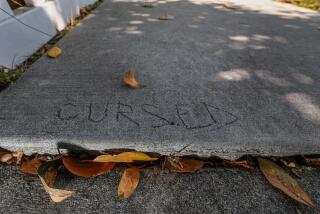There’s No Easy Repair for Cracked Slab
- Share via
Question: Our house has a concrete slab and was built on what’s called “expansive soil” in 1962. The concrete reacts with the soil and lumps of white powder have formed under the carpet and have broken tile. We’re told that the problem is prevented on new construction by laying a sheet of plastic down before the slab is poured, but what can we do?
J.E.
Costa Mesa
Answer: “This is not an uncommon problem in Orange County, and unfortunately a permanent fix is very expensive,” says Jim Gorman of Rancho Lumber in Westminster. “What happens is at each point where the slab has cracked, the deteriorated concrete moves up and surfaces.
“A temporary way to correct the problem would be to fix the cracks, filling them with a product like Fix-All, and using a concrete sealer on the area after it dries. This will stop the powder from coming up the cracks for now, but later cracks will have to be treated the same way. A concrete contractor can apply a two-part epoxy to the slab that permanently seals it, but it’s an expensive job.”
Q: Our house has plaster-and-lathe interior walls, and we’re having problems with moisture. All the north-facing walls tend to be wet and mildewy. We’ve tried circulating the air, which hasn’t helped, and the problem seems to be worse with the damp weather we’ve been having. Any suggestions?
C.V.
La Palma
A: “Generally, moisture problems occur on walls because of poor air circulation, so I’d start there,” says Linda Wiegman of Amco Building and Plumbing Supply in Costa Mesa. “Mildew will grow in areas where the humidity is high and the air is still. Even though you’ve tried circulating the air, I’d suggest running a powerful fan in the rooms periodically to get the air moving. The wet weather we’ve been having has probably contributed to the moisture on your walls and has made it worse. As you get the air circulating and the weather dries up, you should notice a difference in the moisture.”
Q: We have an open-beamed ceiling in our kitchen, and we’d like to hang over the eating bar lights that can be turned on and off at a wall switch. We don’t want to go through the ceiling and roof, because we’ve just had a new roof put on. Do you have any ideas?
K.R.
Garden Grove
A: “The difficulty of this job is going to depend on how the house is laid out,” says Cathy McNally of McNally Electric in Los Alamitos. “You, or an electrician, will probably have to fish a wire from behind the wall up to the ceiling. A wire mold can then be run up against a beam to where you want the lights to go. This isn’t as invisible as running the wiring above the ceiling, But you can paint the wiring or tuck it in so it’s not as conspicuous. If you haven’t done this kind of wiring before, it’s probably best to have a professional do it, since it can take quite a long time to do the job right.”
Q: My kitchen cabinets are in excellent shape, but I’d like to paint them. They have a walnut stain with a semi-gloss varnish sealing them. I’d like to use white and drag a blue Shaker color through the paint. What’s the procedure?
M.E.
Mission Viejo
A: “I’m not sure about ‘dragging’ blue paint across the cabinets; I’d assume you’re trying for an antique look,” says Andy Carter of Sinclair Paint in Costa Mesa.
“To get them white, you’ll have to remove the doors and sand the gloss finish off all parts you want to paint. Use a good quality primer, then an oil or latex-base enamel. Oil-based enamel provides a stronger finish, but whites tend to yellow. Latex enamels hold their color but aren’t as tough. If you’re determined to use white, you might try an oil-based off-white that won’t show the yellow as much.”
More to Read
Sign up for Essential California
The most important California stories and recommendations in your inbox every morning.
You may occasionally receive promotional content from the Los Angeles Times.










